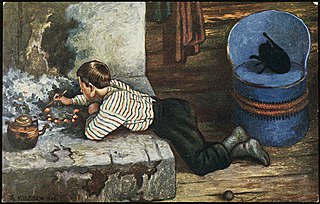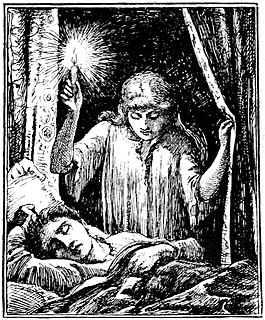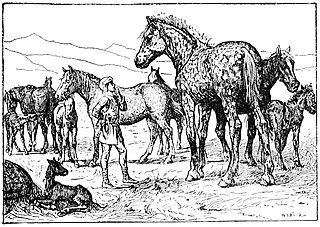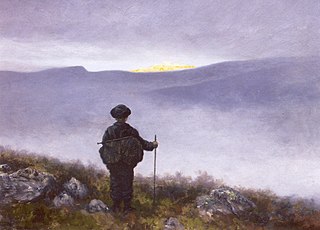Sir George Webbe Dasent, D. C. L. (1817–1896) was a British translator of folk tales and contributor to The Times.

Palnatoke or Palnatoki, sometimes written Palna-Toki or Palna Toki, was a legendary Danish hero and chieftain of the island of Fyn. According to the Jómsvíkinga saga, Palnatoki founded the brotherhood of Jomsvikings and established its laws.

"Three Billy Goats Gruff" is a Norwegian fairy tale collected by Peter Christen Asbjørnsen and Jørgen Moe in their Norske Folkeeventyr, first published between 1841 and 1844. It has an Aarne-Thompson type of 122E. The first version of the story in English appeared in George Webbe Dasent's translation of some of the Norske Folkeeventyr, published as Popular Tales from the Norse in 1859. The heroes of the tale are three male goats who need to outsmart a ravenous troll to cross the bridge to their feeding ground.

Gísla saga Súrssonar is one of the sagas of Icelanders. It tells the story of Gísli, a tragic hero who must kill one of his brothers-in-law to avenge another brother-in-law. Gisli is forced to stay on the run for thirteen years before he is finally hunted down and killed. The events depicted in the saga take place between 860 and 980. The saga existed in oral tradition until it was recorded, most likely in the 13th century. In 1981, it was made into a film titled Outlaw: The Saga of Gisli.

Ashlad is a main character in a number of tales collected in Asbjørnsen and Moe's Norwegian Folktales.
In Irish mythology Tír na nÓg or Tír na hÓige is one of the names for the Celtic Otherworld, or perhaps for a part of it. Tír na nÓg is best known from the tale of Oisín and Niamh.

"East of the Sun and West of the Moon" is a Norwegian fairy tale.
Tatterhood is a Norwegian fairy tale collected by Peter Christen Asbjørnsen and Jørgen Moe.

"The Master Thief" is a Norwegian fairy tale collected by Peter Chr. Asbjørnsen and Jørgen Moe. The Brothers Grimm included a shorter variant as tale 192 in their fairy tales. Andrew Lang included it in The Red Fairy Book. George Webbe Dasent included a translation of the tale in Popular Tales From the Norse. It is Aarne–Thompson type 1525A, Tasks for a Thief.
Farmer Weathersky is a Norwegian fairy tale collected by Peter Chr. Asbjørnsen and Jørgen Moe in Norske Folkeeventyr.

Dapplegrim (Grimsborken) is a Norwegian fairy tale collected by Peter Christen Asbjørnsen and Jørgen Moe in their Norske Folkeeventyr. Andrew Lang included it in The Red Fairy Book.

Soria Moria Castle is a Norwegian fairy tale made famous by Peter Christen Asbjørnsen and Jørgen Moe in their classical Norske Folkeeventyr. Later Andrew Lang included the story in his series of fairy tale collections in The Red Fairy Book.
Vesle Åse Gåsepike is a Norwegian fairy tale collected by Peter Christen Asbjørnsen and Jørgen Moe in Norske Folkeeventyr. It has also been translated as Little Lucy Goosey Girl, and classified as Aarne-Thompson tale type 870A.
"The Three Aunts" is a Norwegian fairy tale collected by Peter Christen Asbjørnsen and Jørgen Moe in Norske Folkeeventyr.
The Lassie and Her Godmother is a Norwegian fairy tale collected by Peter Christen Asbjørnsen and Jørgen Moe in Norske Folkeeventyr.

"The Old Dame and her Hen" is the English title given by Dasent to the Norwegian folk tale, Asbjørnsen and Moe’s number 35.

"Hans in Luck" is a fairy tale of Germanic origin, recorded by the Brothers Grimm. It is Aarne-Thompson type 1415.

"Boots Who Made the Princess Say, 'That's a Story'" or "The Ash Lad Who Made the Princess Say, 'You're a Liar'" is a Norwegian fairy tale collected by Peter Christen Asbjørnsen and Jørgen Moe in Norske Folkeeventyr.

Shooting an apple off one's child's head, also known as apple-shot is a feat of marksmanship with a bow that occurs as a motif in a number of legends in Germanic folklore. In the Stith Thompson Motif Index it is F661.3, described as "Skillful marksman shoots apple from man's head" or "apple shot from man's head", though it always occurs in the form of the marksman being ordered to shoot an apple off his own son's head. It is best known as William Tell's feat.
Why the Bear Is Stumpy-Tailed is a Norwegian fairy tale collected by Peter Christen Asbjørnsen and Jørgen Moe in Norske Folkeeventyr.












